Friday, January 9, 2015
The Technological Maturity of Chinese AESA Technology & Strategic ImpactsBackground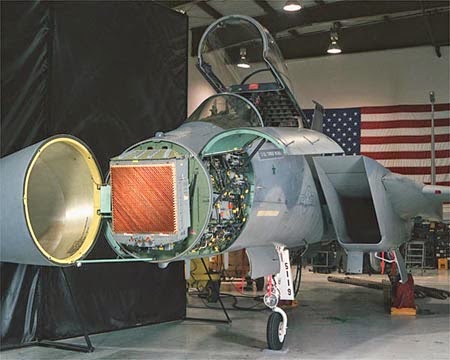
Image 1: APG-63(V)2 radar installed on an F-15C. The APG-63(V)2 was the first fighter mounted active electronically scanned array (AESA) radar to enter service worldwide. The first American F-15C unit to receive the new radars were stationed at Elmendorf AFB in 2000. In comparison, the first European AESA entered operational service in 2012 and the first Russian AESA equipped fighter (Mig-35) will not enter service until 2016. The initial US technological lead in AESA technology is attributable to substantial investments made in the late stages of the Cold War. Image retrieved via Defense Industry Daily.
Author's Note: During the research process for another article, it became apparent that very few credible, verifiable, and non-speculative English based source materials existed on the subject of PLA fighter radars. Basic information, such the proper name or designation of a radar system utilized by a particular fighter often varies between sources; performance figures associated with domestically produced radars are even harder to verify. This article's intent is to determine the technological maturity of Chinese AESA technology relative to US, Russian, Israeli, and European systems as well as to determine the strategic impacts of future Chinese AESA fighter radars.
AESA radars represent a significant increase in detection power, reliability, and electronic warfare capabilities when compared to older electronically scanned arrays (ESA) and mechanically scanned arrays (MSA). This article largely focuses on more technical aspects of AESAs but the basics of AESA capabilities and associated technologies are cogently detailed by Karlo Kopp in "Active Electronically Steered Arrays A Maturing Technology". A brief overview of AESA technology is detailed below followed by an analysis of PRC AESA systems.
Generally, measuring the number of transmit receiver (T/R) modules an AESA has is indicative of its raw detection power performance. Three main determinants dictate the maximum number of transmit receiver modules a fighter radar can accommodate: the volume of the aircraft’s nose, the technological maturity of the firm/country’s T/R module packaging technology, and the effectiveness of the radar's thermal management system(s). The volume of the nose is a fairly intuitive constraint, the larger an aircraft’s nose, the larger the radar can be. For example, the F-15C’s nose cone is able to accommodate the much larger 1,500 T/R element APG-63V(3) radar vs. the F-16C Block 60 with its comparatively smaller nose cone and its 1,000 T/R element APG-80 AESA. Packaging technology refers to how many individual T/R modules can be installed within the finite space usually accomplished by reductions in size of the individual T/R modules. The more technologically advanced a firm’s T/R packaging technology is, the smaller the individual T/R modules will be resulting in an increased density of the layout of T/R modules within the array. Thus, advancements in packaging technology enable engineers to accommodate more T/R modules within the fixed volume of the aircraft's nose.
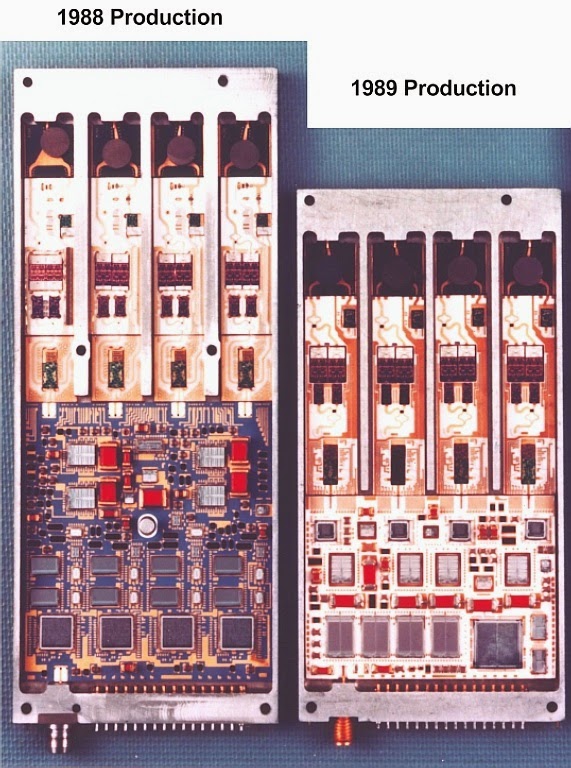
Image 2: US early production quad packed transmit receiver modules. The United States no longer produces quad channel T/R modules and has since produced single T/R module designs. Less advanced AESAs such as the Zhuk-AE utilize multi-T/R channel designs, it is possible China's first generation of AESAs also utilize a multi-T/R channel design. Image Credit: Air Power Australia.
Lastly, thermal management systems are instrumental for the operation of high power AESA radars. Unlike MSA systems, air cooling systems are insufficient to prevent heat related system failures and frequent maintenance issues as Karlo Kopp details,
Due to the behavior of microwave transistor amplifiers, the power efficiency of a TR module transmitter is typically less than 45%. As a result, an AESA will dissipate a lot of heat which must be extracted to prevent the transmitter chips becoming molten pools of Gallium Arsenide - reliability of GaAs MMIC chips improves the cooler they are run. Traditional air cooling used in most established avionic hardware is ill suited to the high packaging density of an AESA, as a result of which modern AESAs are liquid cooled.US designs employ a polyalphaolefin (PAO) coolant similar to a synthetic hydraulic fluid. A typical liquid cooling system will use pumps to drive the coolant through channels in the antenna, and then route it to a heat exchanger. That might be an air cooled core (radiator style) or an immersed heat exchanger in a fuel tank - with a second liquid cooling loop to dump heat from the fuel tank. In comparison with a conventional air cooled fighter radar, the AESA will be more reliable but will require more electrical power and more cooling, and typically can produce much higher transmit power if needed for greater target detection range performance (increasing transmitted power has the drawback of increasing the footprint over which a hostile ESM or RWR can detect the radar. – Kopp, 2014 Chinese AESAs
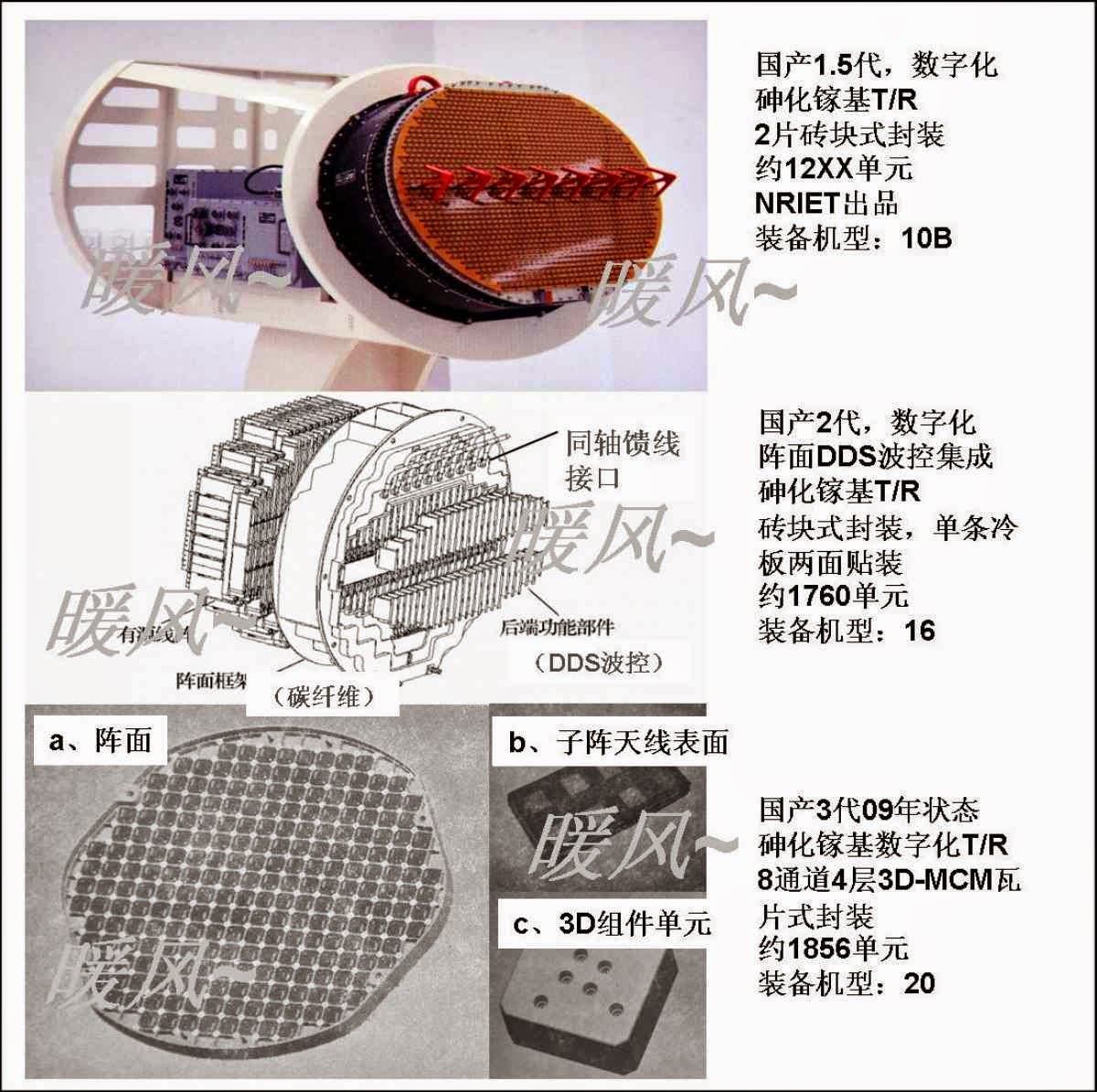
Image 3:The image which allegedly describes the number of T/R modules within the J-10B, J-16, and J-20 has been posted on numerous defense forums since at least December of 2013.
Chinese defense forums have posted copies of the image above which claim to cite the J-20’s AESA T/R module count at 1,856, the J-16’s at 1,760, and the J-10B at 1,200 T/R modules. It is likely the J-10B is the first Chinese fighter aircraft to feature an AESA; J-10B units achieved initial operational capability (IOC) in October of 2014. The volume of the J-10s nose cone is not substantially different from that of the F-16 or the Israeli Lavi from which the J-10 is partially based. Therefore, if one were to assume China had reached parity with the United States in packaging technology, the 1,200 T/R module figure would be plausible but slightly high. For comparison, the APG-80 AESA for the F-16C/D Block 60 has 1,000 T/R modules (DSB, 2001). However, it is unlikely that China has been able to reach parity with the United States in terms of packaging technology on their first generation AESA design. Neither Russia nor Israel was able to field 1,000 T/R element arrays within their first generation fighter mounted AESAs for similar nose volumes as the F-16 with the Mig-35 and Israeli F-16 respectively.
Russia’s first fighter mounted AESA radar, the Zhuk-AE, contained 652 T/R modules and was unveiled in 2007. The Israeli --- ELM-2052 AESA radar, which has been marketed for both the F-16 and the FA-50 – a joint Korean Aerospace Industry and Lockheed Martin F-16 derivative, has roughly 512 T/R modules (Trimble, 2014). ------The only firm outside of the United States that was able to produce a 1,000 T/R element within one generation was the French avionics firm Thales with its RB2E radar (Avionics Today, 2009). -While the relative technological maturity of European, Israeli, and Russian AESAs is not directly indicative of the relative technological maturity of China’s packaging technology, it is an indicator that the first generation AESA produced by China is likely not on par with the US which is generally recognized as having the most technological mature T/R packaging technology (Kopp, 2014).

Image 4: T/R module count of US AESAs based upon the 2001 Defense Science Board report "Future DoD Airborne High-Frequency Radar Needs/Resources"(link provided in Source 1 citation, refer to page 6). Image Credit: Air Power Australia, 2008.
The prospect of China’s T/R packaging technology being on par with US firms within a single generation of radars is even more dubious when one examines the preference for an incremental technological development within the Chinese aerospace industry. Several Chinese aviation authors have hypothesized that the J-10B serves as a “technological stepping stone” with respect to the development of the more advanced J-20. For example, Feng Cao argues the J-10B and the J-16 AESAs were likely used to test technology related to the J-20’s AESA which would be a second generation Chinese design. By virtue of the larger nose volumes in the J-16 and J-20 airframes, it is highly probable the two aircraft will feature radars with more T/R modules than the J-10B’s radar.
The J-16 utilizes the Su-27BS airframe which has room for a 0.9-1.1 meter aperture in the nose which is on par with the F-15 and F-22 in terms of volume (Kopp, 2012). The 1,500 element N036 Tikhomirov NIIP AESA has a similar aperture size to the electronically scanned array (ESA) Irbis-E radar featured in the Su-35 series of fighters which shares the base Su-27 airframe. If the 1,760 T/R figure is correct it would indicate the Chinese aerospace industry has eclipsed Russian T/R module packaging technology as the N036 is arguably the most advanced Russian fighter mounted AESA. Similarly, the most advanced US fighter mounted AESAs such as the APG-77(V)2 and APG-82(V)1 contain 1,500 T/R modules*. While the prospect of Chinese avionics firms reaching parity with US and Russian firms is more plausible within two generations of designs, the author is skeptical the 1,760 figure is correct given the unsubstantiated nature of the image and the fairly substantial 260 T/R discrepancy between the J-16 radar figure compared to the most advanced US and Russian AESA designs. Therefore, the author speculates it would be more reasonable to assume a figure between 1,200 and 1,500 T/R modules for the J-16 rather than the 1,760 figure.
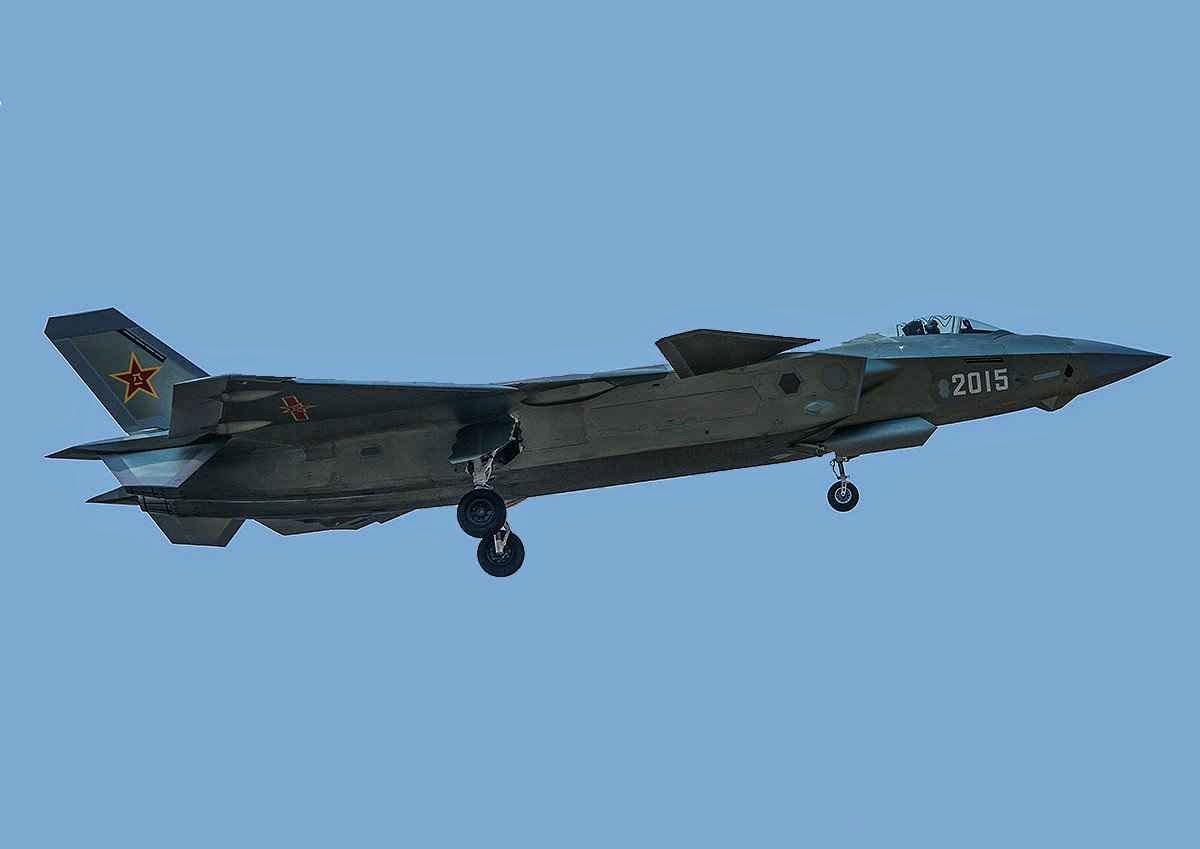
Image 5: The sixth and most recent (as of January 2015) unveiled J-20 testing aircraft model "2015".
The tentative designation for the J-20's AESA is the Type 1475. While the nose volume of the J-20 is certainly large, the jet overall is longer and heavier than the F-22, no credible figures for nose volume were available at the time of this publication. As with the J-16 T/R figure, the J-20 figure is substantially greater than that of the most advanced US and Russian designs. Even if the Nanjing Research Institute of Electronics Technology (NRIET) or the China Leihua Electronic Technology Research Institute (607 Institute) was able to develop sufficient packaging technology that would enable 1,856 T/R modules within the J-20's nose, the density of the T/R modules would create significant cooling problems. For example, Phazotron's single greatest difficulty in designing the Zuk-AE was the AESA's thermal management system (Kopp, 2008). Without an effective cooling system, the Type 1475 would not be reliable at peak power output and would cause significant maintenance issues. Furthermore, with such a high number of T/R modules, the Type 1475 would be vulnerable to radar warning receiver (RWR) systems such as the ALR-94 without a very capable low probability intercept (LPI) mode.
Many discussions with respect to the "relative stealthiness" of fighter aircraft are limited to merely comparing radar cross section estimates while entirely neglecting alternate means of detecting aircraft such as RWRs or other emission locator systems. David Axe succinctly compares the process of how RWRs function to how a flash light carried by another person is easily visible in a dark room. AESAs emit a substantial amount of energy, especially designs with a greater number of T/R modules, which enables passive emission locator systems to detect an AESA. The addition of an LPI software for AESAs mitigates the risk of RWR detection.
The radar's signals are managed in intensity, duration and space to maintain the pilot's situational awareness while minimizing the chance that its signals will be intercepted.More distant targets get less radar attention; as they get closer to the F-22, they will be identified and prioritized; and when they are close enough to be engaged or avoided, they are continuously tracked - Bill Sweetman, 2001
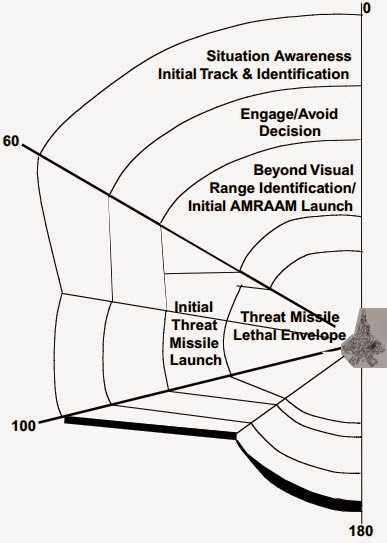 Image 6: Engagement boundaries for the AN/APG-77. Targets automatically receive higher tracking accuracy as they enter engagement boundaries in proximity to the F-22. The boundary concept facilitates automated sensor tasking and efficient sensor usage which contributes towards increased situational awareness and fewer emissions by the array (Ronald W. Brower, 2001). Image Credit: Ronald W. Brower & USAF, 2001. However, LPI software is not foolproof as demonstrated between tests involving F-22s and a CATbird avionics testbed equipped with the F-35's avionics package*. The F-35's avionics were able to jam and track multiple F-22 and F-15 radars during the exercise (Fulghum, Sweetman, Perrett & Wall, 2011). Image 6: Engagement boundaries for the AN/APG-77. Targets automatically receive higher tracking accuracy as they enter engagement boundaries in proximity to the F-22. The boundary concept facilitates automated sensor tasking and efficient sensor usage which contributes towards increased situational awareness and fewer emissions by the array (Ronald W. Brower, 2001). Image Credit: Ronald W. Brower & USAF, 2001. However, LPI software is not foolproof as demonstrated between tests involving F-22s and a CATbird avionics testbed equipped with the F-35's avionics package*. The F-35's avionics were able to jam and track multiple F-22 and F-15 radars during the exercise (Fulghum, Sweetman, Perrett & Wall, 2011).
Implications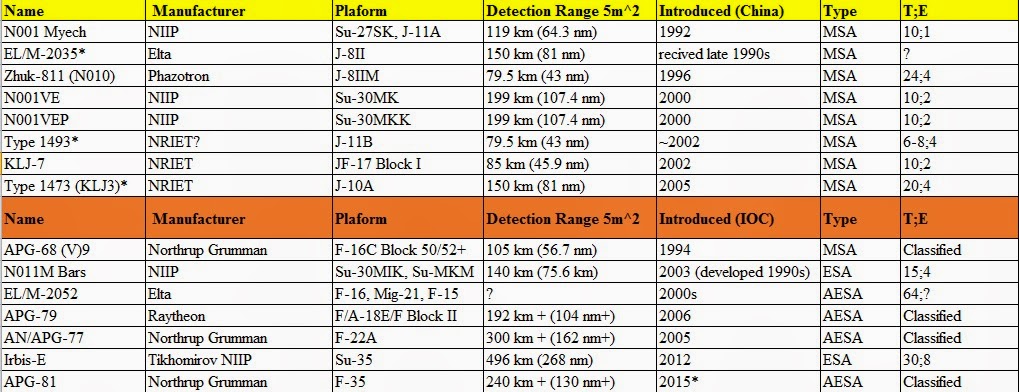
Graphic 1: The data present in graphic 1 are assembled from numerous sources which are cited below. The formula: "(km known) * (new rcs/rcs known)^(0.25) = detection range of new rcs" was used to calculate many of the figures. T;E = maximum number of targets tracked & maximum number of targets engaged simultaneously.
In summary, the high T/R module counts detailed in image 3 are likely too high to be considered legitimate. This is not to marginalize the significant advancements made by the Chinese aerospace industry in avionics, but the level of misinformation and disinformation prevalent within publications detailing Chinese military systems necessitates a strict research approach. The figures cited in image three are not consistent with what one could reasonably assume given the technological development of fighter mounted AESAs within other countries such as Russia, Israel, and the United States. Ultimately, determining the exact T/R module count for various Chinese AESAs is of little consequence when compared to the underlying trend that Chinese avionics firms have made staggering advancements over the past decade.
The vast majority of fighter aircraft currently deployed by the People's Liberation Army Air Force (PLAAF) use Soviet designed MSAs such as the N010 and N001 series. Even the most capable of China's MSAs, the N0001VEP equipped on the Su-30MKK, can only track ten targets while engaging two simultaneously. Originally, the J-11 could only track ten targets and engage one before being upgraded to engage two targets simultaneously after 2003 (Global Security, 2014). The addition of even a comparatively primitive AESA would significantly increase the lethality of China's fourth and fifth generation fighter forces. One of the main constraints of China's existing fighter force detailed in graphic one is the limited detection range, tracking, and engagement numbers of the MSAs relative to Russian ESAs and American AESAs.
In a 2008 RAND report, Air Combat Past, Present and Future, John Stillion and Scott Perdue state the PLAAF has at least a three to one numerical superiority over the United States in a conflict over the Taiwanese strait around 2020. As part of the Russian method of fighter employment, each Flanker is equipped with between eight and twelve beyond visual range (bvr) air-to-air missiles in which multiple missiles are fired against each target to increase the probability of a kill (pk). In a modern digital radio frequency memory jamming environment, even capable radar guided missile such as the AIM-120 will likely have lower than a 0.50 pk (RAND, 2008). Hence the Russian bvr doctrine of launching at least two missiles against a single target as the pk increases as the number of missiles fired increases.
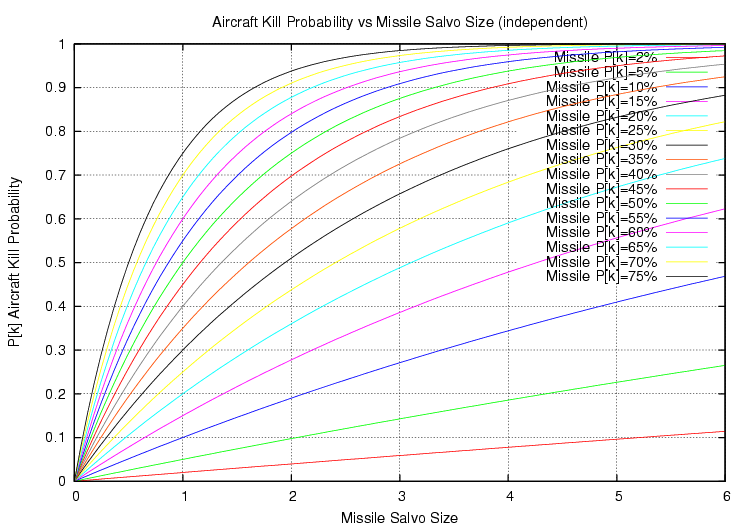
Image 7: Pk vs. missile salvo size. The AIM-120 has a pk. of 0.46 in combat against non-jamming targets. Image Credit: Air Power Australia, 2008.
The addition of fighter mounted AESA radars would enable Chinese pilots to launch missiles against a larger number of targets in the opening salvo of an air-to-air engagement as well as providing increased situational awareness for Chinese pilots when compared to current MSAs. The ability to engage more targets at beyond visual range effectively complements the PLAAF's numerical superiority by allowing each aircraft to make full use of their comparatively larger payload of air-to-air missiles. It is worth noting that the United States will continue to deploy large numbers of fourth generation aircraft such as the F-15C, F-16C/D, and F/A-18E/F into the late 2020s to 2030s; these aircraft will be especially put at risk as a result of improvements in Chinese avionics with respect to improved PLAAF bvr capabilities.
The enhancement of situational awareness gained by the deployment of AESAs is especially important given the shift within the PLA from Soviet and Russian inspired doctrines towards embracing an increasing number of American combat doctrines such as network centric warfare:
Almost all of the PLA’s 2013 exercises focused on operating in 'informationized' conditions by emphasizing system-of-systems operations, a concept that can be viewed as the Chinese corollary to U.S. network-centric warfare. This concept requires enhancing systems and weapons with information capabilities and linking geographically dispersed forces and capabilities into an integrated system capable of unified action. These operational training reforms are a result of the Outline of Military Training and Evaluation (OMTE), which was last published in mid-2008 and became standard across the PLA on January 1, 2009. Since that time, the PLA has pushed to achieve OMTE objectives by emphasizing realistic training conditions, training in complex electromagnetic and joint environments, and integrating new technologies into the PLA force structure. - Military and Security Developments Involving the People’s Republic of China 2014, Department of Defense, 2014
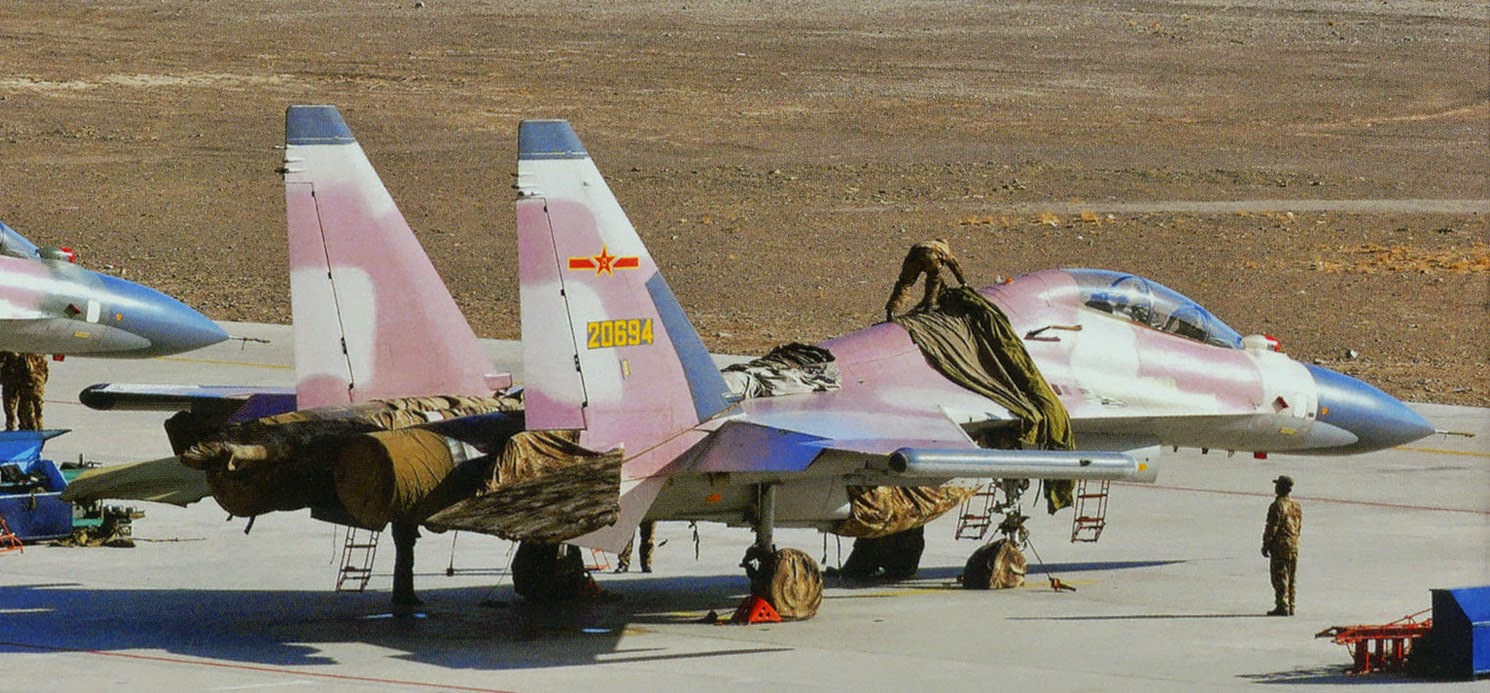
Image 8: PLAAF Su-30MKK aggressor unit. Image retrieved via Sinodefense.
PLAAF pilots continue to improve their skills as a result of realistic large scale exercises such as Red Sword/Blue Sword and accumulate higher numbers of practice flight hours per year. PLAAF pilots accumulate 200 flight hours per year compared to pre-sequestration US fighter pilots accumulating 250 to 300 flight hours per year in their aircraft. The combination of new AESAs, adoption of new fighter employment doctrines, and improved pilot training will make the PLAAF an increasingly formidable fighting force and a near peer competitor to the USAF. While the PLAAF is unlikely to reach parity with the USAF in the near future, the advancements made by the PLAAF are substantial enough to pose a significant threat to US forces in the region given the PLAAF's in theatre numerical superiority. A USAF official interviewed by the National Interest astutely summarized the PLAAF's ongoing modernization program:
I think we can probably keep a slight advantage for quite some time, but a slight advantage means significant losses and less of a deterrent...Lets pretend the F-22 confronts current air-to-air threats outside of a SAM [surface-to-air missile] environment and has a 30 to one kill ratio today versus a [Sukhoi] Su-30 or [Shenyang] J-11. When the J-20 and J-31 come around, even a three to one kill ratio advantage becomes costly...Our competitors know the current reality and are working very hard to avoid the wide gap we have created by investing in those planes,they represent their attempt and creating parity in the skies. NOTES
*AN/APG-77 – the 1,500 T/R figure comes directly from a Defense Science Board report published by the Office of the Secretary of Defense in 2001. The author judged credibility of direct source material to be more authentic than the commonly cited 2,000 or 1,994 T/R figure. The latter of the three figures was determined by counting the T/R modules visually by members of the F-16.net forums. Neither the APG-77(V)1 nor the APG-77(V)2 upgrades include added T/R modules. Rather, the version one upgrade adds surface aperture radar mode and (V)2 adds commonality with the APG-81 with respect to maintenance purposes.
*The F-22 is likely able to overcome the limitations of LPI in an actual combat with the assistance of the ALR-94, sensor fusion, and tactics described by Bill Sweetman in article "The Next Generation" published in the Journal of Electronic Defense in 2000 (An online copy of the article is available in the source 41 citation courtesy of F-16.net).
Graphic 1 Related Notes
*EL/M-2035 - figures are from the EL/M-2032 of which the EL/M-2035 is a derivative. Also the figure provided is the maximum detection range of the radar in an air-to-air and does not give a corresponding rcs target
*Type 1493 - the name and tracking numbers provided by Sinodefense "PLAAF Su-27/J-11 Flanker". Kopp states the J-11B radar strongly resembles the Zhuk-27 (N010) radar, the J-8II is equipped with a N010 derivative, the Zhuk-811. Numerous Chinese internet sources claim the J-11B is equipped with an AESA radar but these claims are baseless and unsubstantiated. An official SAC image (below) clearly show a mechanically scanned array within the nose of the aircraft (available on Air Power Australia website). Similarly, many Chinese internet sources claim the J-11B incorporates stealth coatings and a reduced radar cross section along with an AESA. David Shalpak, The Chinese Air Force: Evolving Concepts, Roles, and Capabilities, dismisses the reduced rcs claims (pg. 196). Clearly a great deal of misinformation exists with respect to the J-11B.

*Type 1473 - The maximum detection range figures listed for the Type 1473 are from the EL/M-2032 which is arguably its closest analogue with published performance data (the Israelis supplied EL/M-2032s to China in the early 1990s which was developed into the Type 1473). The tracking and engagement figures for the Type 1473 are provided by Sinodefense. *AN/APG-81 - 2015 service date refers to the scheduled first F-35B deployment by the USMC
Sources
My apologies for any formatting discrepancies, blogger has a terrible text editor with respect to numbered lists and indents. What is displayed in my preview often does not match what is actually displayed on the site and can require edits in HTML to fix.
Future DoD Airborne High-Frequency Radar Needs/Resources, Office of the Under Secretary of Defense For Acquisition and Technology, 2001. http://www.acq.osd.mil/dsb/reports/ADA391893.pdf Analysis: End of year surge for Chengdu J-20 fighter programme, Richard D Fisher Jr, 2015. http://www.janes.com/article/47601/analysis-end-of-year-surge-for-chengdu-j-20-fighter-programme Sukhoi Flankers The Shifting Balance of Regional Air Power, Karlo Kopp, 2014. http://www.ausairpower.net/APA-Flanker.html Chinese naval J-11s spotted in the open, Ted Parsons, 2010. http://www.globalmil.com/Military/News/Janes/2010/0511/236.html The Naval Institute Guide to World Naval Weapon Systems, Norman Friedman, 2006. http://books.google.com/books?id=4S3h8j_NEmkC&pg=PA222&lpg=PA222&dq=Type+346+radar&source=bl&ots=hJSwQWWWdV&sig=xsiTOMguyGXouqzBdsuChsQQ_Ao&hl=en&sa=X&ei=r-NzVIuMH-_vigLjtIDIBw&ved=0CC0Q6AEwAg#v=onepage&q=Type%20346%20radar&f=false The Naval Institute Guide to World Naval Weapons Systems, Norman Friedman, 1997 version. http://books.google.com/books?id=l-DzknmTgDUC&pg=PA199&lpg=PA199&dq=N010+radar+%22km%22&source=bl&ots=2tbPHVmbLl&sig=4MeoMH5fXh8baRGnojcW6jDZev8&hl=en&sa=X&ei=40xxVNrNG5HqiALqzIH4DQ&ved=0CDoQ6AEwBA#v=onepage&q=N010%20radar%20%22km%22&f=false Serious Squall, Jean-Michel Guhl, 2009. http://www.aviationtoday.com/av/issue/cover/Serious-Squall_32315.html#.VHFucIvF-So "Vigorous Dragon” Fighter Jets are a Full Set, Soon to be a Regiment, hJeffrey Lin and P.W. Singer, 2014. http://www.popsci.com/blog-network/eastern-arsenal/j-10b-%E2%80%9Cvigorous-dragon%E2%80%9D-fighter-jets-are-full-set-soon-be-regiment Fourth known J-20 prototype makes first flight, Richard D Fisher Jr, 2014. http://www.janes.com/article/41254/fourth-known-j-20-prototype-makes-first-flight PLA-AF and PLA-N Flanker Variants, Karlo Kopp, 2014. http://www.ausairpower.net/APA-PLA-Flanker-Variants.html Phazotron Zhuk AE/ASE Assessing Russia's First Fighter AESA, Karlo Kopp, 2014. http://ausairpower.net/APA-Zhuk-AE-Analysis.html Active Electronically Steered Arrays A Maturing Technology, Karlo Kopp, 2014. http://www.ausairpower.net/aesa-intro.html Active Electronically Scanned Array (AESA) Fire Control Radars, Northrup Grumman. http://www.northropgrumman.com/Capabilities/ANAPG80AESARadar/Documents/AESA.pdf Raytheon AESA Research: Past, Present and Future, Mike Sarcione, Porter Hull, Colin Whelan, Doug Tonomura, Thomas V. Sikina, Jim Wilson and Robert E. Desrochers II, 2014. http://www.raytheon.com/newsroom/technology_today/2014_i1/aesa.html Airshow China 2014: Russia to supply China with more RD-93 turbofans, Nikolai Novichkov, 2014. http://www.janes.com/article/45852/airshow-china-2014-russia-to-supply-china-with-more-rd-93-turbofans Raytheon (Hughes) AIM-120 AMRAAM, Andreas Parsch, 2007. http://www.designation-systems.net/dusrm/m-120.html PLAAF SU-27 / J-11 ‘FLANKER’, Sinodefense, 2014. http://sinodefence.com/plaaf-su-27-j-11-flanker/ Fighters (Cont.), jetfight2000. http://jetfight.stormpages.com/J-10_J-11_FC-1.htm Flanker Radars in Beyond Visual Range Air Combat, Karlo Kopp, 2014. http://ausairpower.net/APA-Flanker-Radars.html#mozTocId228428 ISRAEL & IN FOCUS: AESA radar emerges from US export shadow, Stephen Trimble, 2014. http://www.flightglobal.com/news/articles/israel-amp-in-focus-aesa-radar-emerges-from-us-export-394864/ EL/M-2052, IAI. http://www.iai.co.il/sip_storage/files/4/36834.pdf Indonesia Air Force Handbook, USA International Business Publications 2007, http://books.google.com/books?id=RS8Fz-NWAIkC&pg=PA100&lpg=PA100&dq=N010+radar+%22km%22&source=bl&ots=F0shDtGQ60&sig=u7usDAvdIgbWWLLKeAv7WzJdyCo&hl=en&sa=X&ei=eEtxVMzQJe71igK3xYGgDw&ved=0CE4Q6AEwBzgK#v=onepage&q=N010%20radar%20%22km%22&f=false Chinese Military Aviation, Hui Tong, accessed 2015. http://chinese-military-aviation.blogspot.com/p/fighters-ii.html Chinese Airborne Radars, Paul Martell-Mead, 2013. http://www.secretprojects.co.uk/forum/index.php/topic,19984.0/prev_next,prev.html#new First Typhoon Flight With AESA Could Open Door to Exports, Tom Kington, 2014. http://www.defensenews.com/article/20140318/DEFREG01/303180028/First-Typhoon-Flight-AESA-Could-Open-Door-Exports 6th J-20 Stealth Fighter Rolls Out, More to Soon Follow, Jeffrey Lin and P.W. Singer, 2014. http://www.popsci.com/6th-j-20-stealth-fighter-rolls-out-more-soon-follow Stealth Radar Tests On Passenger Jet, Jeffrey Lin and P.W. Singer, 2014. http://www.popsci.com/blog-network/eastern-arsenal/stealth-radar-tests-passenger-jet AESA’s Advantages, Ed McKenna, 2008. http://www.aviationtoday.com/av/military/AESAs-Advantages_25395.html#.VKx5rivF-So Stretching the ‘16, Frank Colucci, 2014. http://www.aviationtoday.com/av/issue/feature/Stretching-the-16_80858.html#.VKx6MSvF-So Northrop Grumman Completes Demonstrations of SABR for F-16s, Avionics Today, 2013. http://www.aviationtoday.com/av/topstories/Northrop-Grumman-Completes-Demonstrations-of-SABR-for-F-16s_79011.html#.VKx5xivF-So Radar Refits: F-15s Looking for the AESA Edge, Defense Industry Daily, 2014. http://www.defenseindustrydaily.com/f-15s-looking-for-the-aesa-edge-04044/ Aiming high: China's air ambitions, Craig Caffrey, 2013/ http://www.janes360.com/images/assets/976/30976/China_aircraft_capabilities_1.pdf China Unveils More Capable Stealth Fighter Prototype, Feng Cao, 2014. http://news.usni.org/2014/03/19/china-unveils-capable-stealth-fighter-prototype Flanker Radars in Beyond Visual Range Air Combat, Karlo Kopp, 2014. http://www.ausairpower.net/APA-Flanker-Radars.html China’s Stealth Aircraft Program Will Face Advanced Defenses, David A. Fulghum, Bill Sweetman, Bradley Perrett and Robert Wall, 2011. http://aviationweek.com/awin/china-s-stealth-aircraft-program-will-face-advanced-defenses Military and Security Developments Involving the People’s Republic of China 2014, Department of Defense, 2014. http://www.defense.gov/pubs/2014_DoD_China_Report.pdf FIGHTER EW., Bill Sweetman, 2000. http://www.f-16.net/forum/viewtopic.php?t=9268
Posted by Matt at 4:05 PM
|












